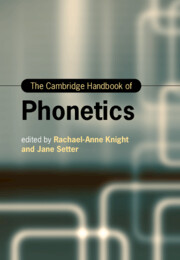Book contents
- The Cambridge Handbook of Phonetics
- Cambridge Handbooks in Language and Linguistics
- The Cambridge Handbook of Phonetics
- Copyright page
- Contents
- Figures
- Tables
- Contributors
- Introduction
- Section I Segmental Production
- Section II Prosodic Production
- Section III Measuring Speech
- 10 Measuring Vowels
- 11 Measuring Consonants
- 12 Measuring Speech Rhythm
- 13 Fundamental Frequency and Pitch
- 14 Observing and Measuring Speech Articulation
- 15 Beyond Functional Speech Synthesis
- Section IV Audition and Perception
- Section V Applications of Phonetics
- Index
- References
11 - Measuring Consonants
from Section III - Measuring Speech
Published online by Cambridge University Press: 11 November 2021
- The Cambridge Handbook of Phonetics
- Cambridge Handbooks in Language and Linguistics
- The Cambridge Handbook of Phonetics
- Copyright page
- Contents
- Figures
- Tables
- Contributors
- Introduction
- Section I Segmental Production
- Section II Prosodic Production
- Section III Measuring Speech
- 10 Measuring Vowels
- 11 Measuring Consonants
- 12 Measuring Speech Rhythm
- 13 Fundamental Frequency and Pitch
- 14 Observing and Measuring Speech Articulation
- 15 Beyond Functional Speech Synthesis
- Section IV Audition and Perception
- Section V Applications of Phonetics
- Index
- References
Summary
This chapter addresses the issue of measuring consonants from an acoustic perspective. After reviewing some of the historic precedents that laid the foundations of acoustic analysis relevant for speech, the chapter provides a detailed report of the techniques for measuring the acoustic information of consonants of six manners of articulation (fricatives, stops, affricates, nasals, approximants, and the group of trills, taps and flaps). The chapter discusses links between the main articulatory characteristics of consonants of each manner and their acoustic correlates, with a focus on those acoustic variables that differentiate consonants within a manner, and on the variety of methods that are employed to measure them. Whenever possible, the chapter gives specific guidelines on how to apply the measurements, highlighting the differences in implementation between authors as well as the advantages and disadvantages of selecting one approach over another. In its closing sections, the chapter discusses some recent studies which address the issue of measuring consonants, provides some practical recommendations for teaching, and identifies some future directions for the topic.
Keywords
- Type
- Chapter
- Information
- The Cambridge Handbook of Phonetics , pp. 285 - 311Publisher: Cambridge University PressPrint publication year: 2021



